
Sutra in Indian literary traditions refers to an aphorism or a collection of aphorisms in the form of a manual or, more broadly, a condensed manual or text. Sutras are a genre of ancient and medieval Indian texts found in Hinduism, Buddhism and Jainism.
Nyāya, literally meaning "justice", "rules", "method" or "judgment", is one of the six orthodox (Āstika) schools of Hindu philosophy. Nyāya's most significant contributions to Indian philosophy were systematic development of the theory of logic, methodology, and its treatises on epistemology.
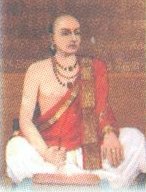
Nannayya Bhattaraka or Nannayya Bhattu was a Telugu poet and the author of Andhra Mahabharatam, a Telugu retelling of the Sanskrit-language Mahabharata. Nannaya is generally considered the first poet of Telugu language. He was patronized by Rajaraja Narendra of Rajamahendravaram. Rajaraja Narendra was an admirer of Mahabharata and wanted the message of the Sanskrit epic to reach the Telugu masses in their own language and idiom. He commissioned Nannaya, a scholar well versed in Vedas, Puranas, and Itihasas for the task. Nannaya began his work in c. 1025 CE and wrote Adi Parvam, Sabaparvam, and a part of Aranyaparvam.
Smṛti Literature in Hinduism The Smṛti texts are a body of Hindu texts usually attributed to an author, traditionally written down, in contrast to Śrutis considered authorless, that were transmitted verbally across the generations and fixed. Smṛti is a derivative secondary work and is considered less authoritative than Sruti in Hinduism, except in the Mimamsa school of Hindu philosophy. The authority of Smṛti accepted by orthodox schools is derived from that of shruti, on which it is based.
Shastra is a Sanskrit word that means "precept, rules, manual, compendium, book or treatise" in a general sense. The word is generally used as a suffix in the Indian literature context, for technical or specialized knowledge in a defined area of practice.
Hindu texts or Hindu scriptures are manuscripts and voluminous historical literature which are related to any of the diverse traditions within Hinduism. Some of the major Hindu texts include the Vedas, the Upanishads, and the Itihasa. Scholars hesitate in defining the term "Hindu scriptures" given the diverse nature of Hinduism, but many list the Agamas as Hindu scriptures, and Dominic Goodall includes Bhagavata Purana and Yajnavalkya Smriti in the list of Hindu scriptures as well.

Paul Jakob Deussen was a German Indologist and professor of philosophy at University of Kiel. Strongly influenced by Arthur Schopenhauer, Deussen was a friend of Friedrich Nietzsche and Swami Vivekananda. In 1911, he founded the Schopenhauer Society (Schopenhauer-Gesellschaft). Professor Deussen was the first editor, in 1912, of the scholarly journal Schopenhauer Yearbook (Schopenhauer-Jahrbuch).

The Vedas are a large body of religious texts originating in ancient India. Composed in Vedic Sanskrit, the texts constitute the oldest layer of Sanskrit literature and the oldest scriptures of Hinduism.
The Vedanga are six auxiliary disciplines of Hinduism that developed in ancient times and have been connected with the study of the Vedas:
Kalpa means "proper, fit" and is one of the six disciplines of the Vedānga, or ancillary science connected with the Vedas – the scriptures of Hinduism. This field of study is focused on the procedures and ceremonies associated with Vedic ritual practice.

Bannanje Govindacharya was an Indian philosopher and Sanskrit scholar versed in Veda Bhashya, Upanishad Bhashya, Mahabharata, Puranas and Ramayana. He wrote Bhashyas (commentaries) on Veda Suktas, Upanishads, Shata Rudriya, Brahma Sutra Bhashya, Gita Bhashya and was an orator. He was awarded the Padma Shri by the Government of India in 2009.
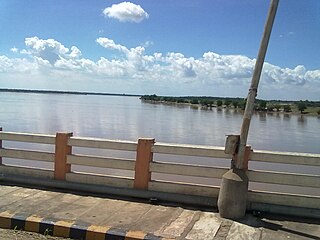
Paata Gannavaram is a village in P. Gannavaram mandal of Dr. B. R. Ambedkar Konaseema district located in the state of Andhra Pradesh, India.

Mysore Hiriyanna (1871–1950) was an eminent Indian philosopher, Sanskrit scholar and authority on Indian aesthetics. He was a Professor of Sanskrit at the University of Mysore and a contemporary of Sarvepalli Radhakrishnan. His classes on Indian Philosophy were comprehensive. His classroom dictations, published by Allen & Unwin in book form as "Outlines of Indian Philosophy" brought Hiriyanna international recognition. This was a seminal work on Indian Philosophy. His other prominent works include "Indian Conception of Values", "Essentials of Indian Philosophy", "The Quest after Perfection" and "Art Experience". He wrote extensively on the Vedic age, mainly on the Upanishads, followed by the evolution of Indian philosophical thought in the post-vedic era, deliberating mainly on Bhagavad Gita, the early years of Buddhism and Jainism. His work on aesthetics was authoritative and dealt mainly with Alamkaras, Aesthetics and Ethics, Method of Art, Indian Aesthetic Values and Art & Morality.

In Hinduism, Brahman connotes the highest universal principle, the Ultimate Reality of the universe. In major schools of Hindu philosophy, it is the non-physical, efficient, formal and final cause of all that exists. It is the pervasive, infinite, eternal truth, consciousness and bliss which does not change, yet is the cause of all changes. Brahman as a metaphysical concept refers to the single binding unity behind diversity in all that exists.
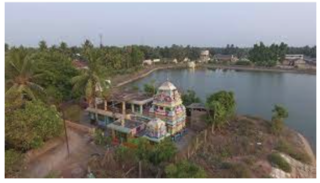
Munganda is a village in East Godavari district of the Indian state of Andhra Pradesh. It is located in P.Gannavaram mandal of Amalapuram revenue division. and is part of Konaseema.
Brij Bihari Chaubey, was an Indian Vedic and Sanskrit scholar based in Hoshiarpur, Punjab. He was awarded the President's Certificate of Honour by A. P. J. Abdul Kalam in 2004.
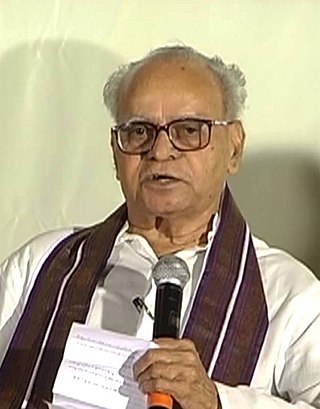
Dr. Pullella Sriramachandrudu was an Indian scholar of Vedanta, Vyakarana and Alankara Sastra and a prolific writer of Sanskrit and Telugu literature. He was widely credited with several books in Sanskrit and Telugu and was best known for translating many difficult Sanskrit works into Telugu the seven volume Telugu edition of the Indian epic, Ramayanam by Valmiki. The Government of India has honored Pullella Srirama Chandrudu in 2011, with the fourth highest civilian award of Padma Shri.
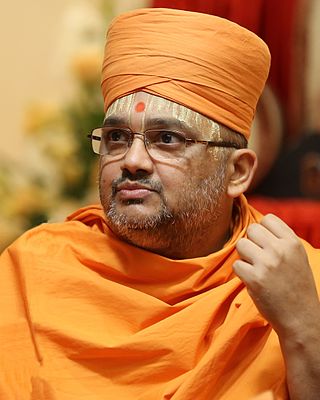
Bhadreshdas Swami is a Sanskrit scholar and an ordained monk of the Bochasanwasi Akshar Purushottam Swaminarayan Sanstha (BAPS). In 2007 he completed the Swaminarayan Bhashyam, a five-volume classical Sanskrit commentary on the Prasthanatrayi. This commentary on three of Hinduism's most notable texts: the Upanishads, Bhagavad Gita, and the Brahma sutras, forms the interpretive foundation of the philosophy of Akshar Purushottam darshana, also known as Swaminarayan darshana, illuminating the Vedic roots of the Akshar Purushottama philosophy, which was propagated by the 19th-century Hindu leader, Swaminarayan and later by Shastriji Maharaj.

Krishnacharya Tamanacharya Pandurangi, also known by the pen name Viswamangala, was an Indian Sanskrit scholar and a notable Indologist. Pandurangi was unique among contemporary Sanskrit scholars, being simultaneously at home among both traditional and modern systems of education. In 1989, the Government of India honoured him with the Rashtrapati Award for his contributions to literature and research.
In Hinduism, Śāstra pramāṇam refers to the authority of the scriptures with regard to puruṣārtha, the objects of human pursuit, namely dharma, artha, kāma (pleasure) and mokṣa (liberation). Together with smṛti, ācāra, and ātmatuṣṭi, it provides pramana and sources of dharma, as expressed in Classical Hindu law, philosophy, rituals and customs.












